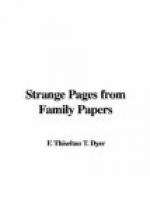Start not, nor deem my spirit
fled;
In me behold the
only skull
From which, unlike a living
head,
Whatever flows
is never dull.
I lived, I loved, I quaff’d,
like thee;
I died: let
earth my bones resign.
Fill up, thou canst not injure
me;
The worm hath
fouler lips than mine.
Where once my wit, perchance,
hath shone,
In aid of others,
let me shine,
And when, alas! our brains
are gone,
What nobler substitute
than wine.
Quaff while thou canst.
Another race,
When thou and
thine, like me, are sped,
May rescue thee from earth’s
embrace,
And rhyme and
revel with the dead.
Why not? since through life’s
little day
Our heads such
sad effects produce;
Redeem’d from worms
and wasting clay,
This chance is
theirs, to be of use.
The skull, it is said, is buried beneath the floor of the chapel at Newstead Abbey.
FOOTNOTES:
[6] Sussex Archaeological Collections xiii. 162-3.
[7] See Notes and Queries, 4th S., XI. 64.
[8] Told by Mr. Moncure Conway in Harper’s Magazine.
[9] “Tales and Legends of the English Lakes,” 96-7.
[10] “Harland’s Lancashire Legends,” 1882, 65-70.
[11] “British Goblins,” 1880, p. 146.
CHAPTER III.
Eccentric vows.
No man takes or keeps a vow,
But just as he sees others
do;
Nor are they ’bliged
to be so brittle
As not to yield and bow a
little:
For as best tempered blades
are found
Before they break, to bend
quite round,
So truest oaths are still
more tough,
And, tho’ they bow,
are breaking-proof.
Butler’s
“Hudibras,” Ep. to his Lady, 75.
Some two hundred and fifty years ago, the prevailing colour in all dresses was that shade of brown known as the “couleur Isabelle,” and this was its origin:—A short time after the siege of Ostend commenced, at the beginning of the seventeenth century, Isabella Eugenia, Gouvernante of the Netherlands, incensed at the obstinate bravery of the defenders, is reported to have made a vow that she would not change her chemise till the town surrendered. It was a marvellously inconvenient vow, for the siege, according to the precise historians thereof, lasted three years, three months, three weeks, three days, and three hours; and her highness’s garment had wonderfully changed its colour before twelve months of the time had expired. But the ladies and gentlemen of the Court, in no way dismayed, resolved to keep their mistress in countenance, and, after a struggle between their loyalty and their cleanliness, they hit upon the compromising expedient of wearing dresses of the presumed colour, finally attained by the garment which clung to the Imperial Archduchess by force of religious obstinacy. But, foolish and eccentric as was the conduct of Isabella Eugenia, there have been persons gifted, like herself, with sufficient mental power and strength of character to keep the vows they have sworn.




